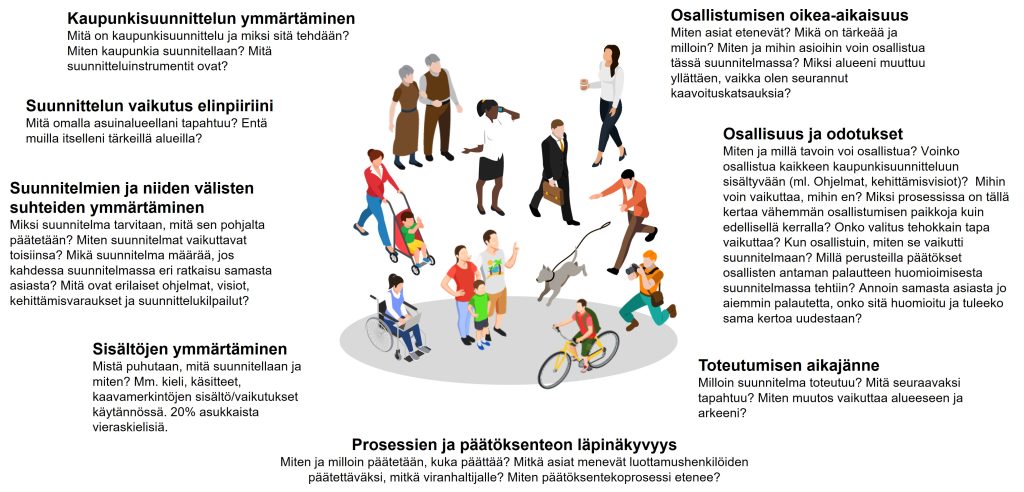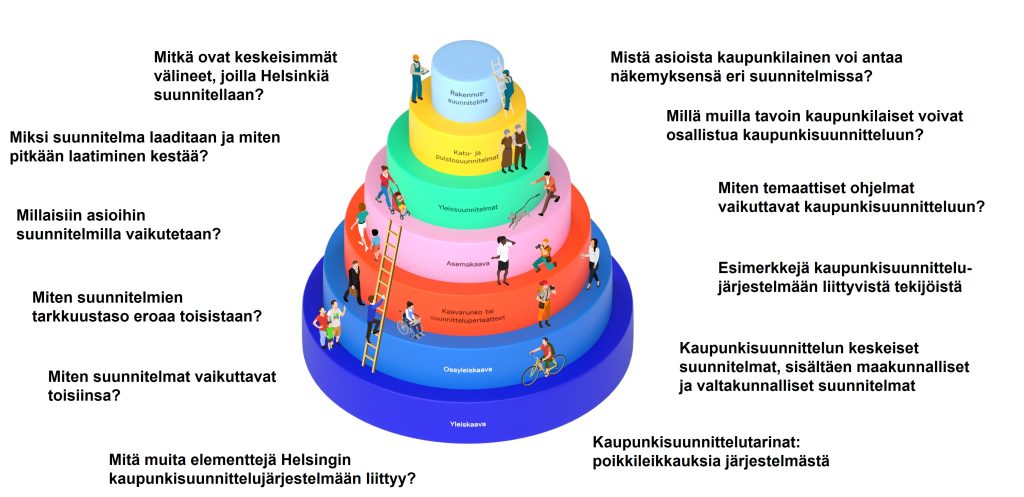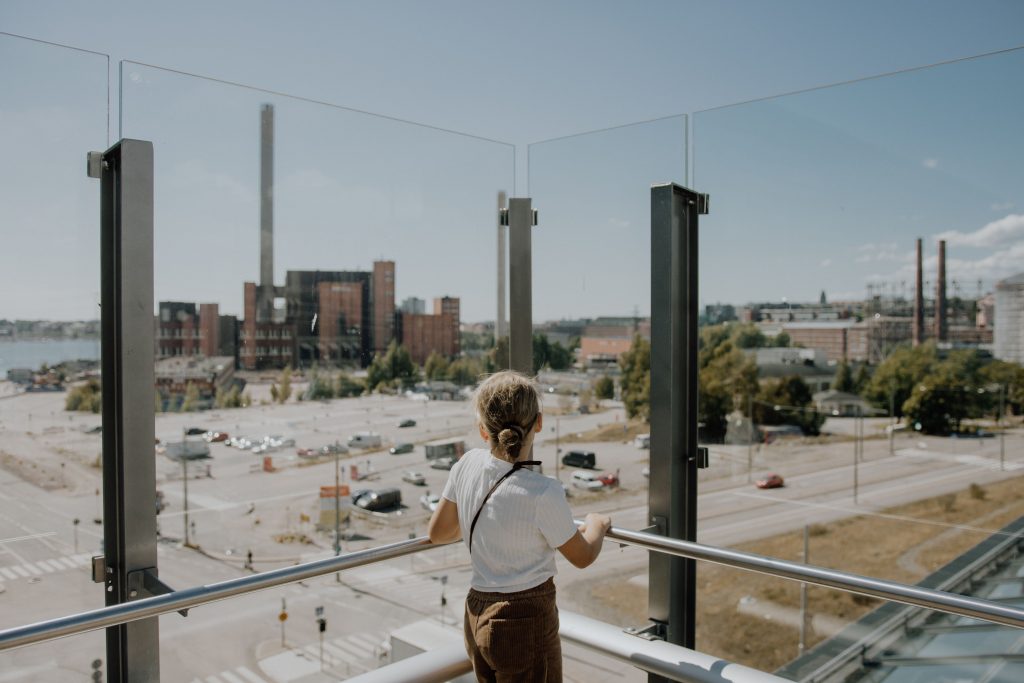Inna Ampuja, Ramboll Finland Oy
September 2023
Buildings, streets and parks, the city blocks formed by them and the city districts made up with these city blocks are the performance stages of our daily lives. Some of them have a long history, while others are still under construction or just finding their form on the planning table. Even the most familiar places can change, as the physical city lives and changes along with urban life. The city is designed for the city residents.
The objective of the work was to describe how the city is being planned in Helsinki. This is one of the first design projects of the City, in which Helsinki has strived to understand and describe the complex system of urban planning.
The urban planning system has a major impact on both the city residents and the City employees.
The city residents’ experience refers to the resident’s role in urban planning, ranging from active participation to watching from the sidelines and resident-centric planning principles. The employee experience, on the other hand, depicts the role of the City’s experts in the planning system.
Defining the urban planning system is not simple: in a city as large as Helsinki, there is a wide variety of different urban planning instruments. Planning instruments refer to e.g. zoning, master and building plans and thematic programmes, such as a campaign to promote walking.
The instruments are linked together not only on the city level, but also on other regional levels from national and regional steering to cooperation models of different levels. In addition to these, several factors in the operational environment, such as megatrends, phenomena and participants, affect the system.
The system is also approached from different perspectives within the city, depending on the role and background of the expert in question. The City may not always act as the designer; sometimes it can be a construction company or a city resident. This is the entity that we refer to when we are talking about the urban planning system.
The description was compiled together
The description of the urban planning system was started by identifying the needs related to it. The views were specified further by interviewing urban planners, interaction designers and communication specialists. Three workshops for commenting on the description drafts were held for the team of experts representing the employee experience. The employee needs were related to understanding the urban planning system in its entirety, as well as to decision-making, the practices of a resident-centric approach and utilisation of related data, and adaptation to the operational environment that is still growing more complex.

A resident jury was established for understanding the needs of city residents. The participants were chosen among the development community of the hel.fi website reform. Two remote workshops were held for the resident jury, reviewing the requirements of the description from the perspective of different city residents.
The needs of residents related to understanding the urban planning system were mainly linked to the changes in their own living environment: participation in urban planning, following and understanding the development of their own residential area, the different timespans of urban planning, and the transparency of the different decisions and stages related to urban planning.

There was also a need to consider how the new, resident-centric operational models could be linked as part of the urban planning system. Participatory budgeting and placemaking were identified as such models, among other methods. The City is currently piloting the operational models of placemaking.
Planning ‘cake’ brings the urban planning system together
The description was designed to meet the needs of both city residents and employees. Part of the description is intended for the City’s internal use, for example in induction processes, information sharing and in the development of the planning system. The sections targeted at the city residents make the urban planning process visible from different perspectives and improve the residents’ awareness of their own influencing opportunities.
The contents of the urban planning system were divided by themes and saved into an extensive material bank, from where the City can select the contents best suited to the purpose. The contents of the description have been presented in Figure 3.
The key planning layers impacting the urban structure were chosen as the framework of the description, covering the entire planning process from the master plan to the building plans. It was not possible to describe all the planning instruments in detail, but the most central information needs that had emerged during the process were met. Services maintaining the built city were also left outside the description.

Typically, urban planning has been described as instrument-specific linear processes. However, in this description, there was a need to highlight the whole planning system, including the connections between the planning instruments. A ‘planning cake’ was established as the description format, depicting the connection between the key planning instruments: the basis of urban planning is the master plan for the whole city, upon which the more detailed plans are built.
The description comprises the following sections:
- main planning principles on the level of the whole city and the city districts
- descriptions of the key planning instruments
- thematic cakes, where the same theme is depicted parallel to all instruments
- more extensive entities that have presented the role of other instruments impacting urban planning (such as a campaign for promoting walking, a development reservation or a design competition) alongside the more traditional planning instruments
- urban planning stories, which describe the planning system in certain example sites.
The description is primarily a living document, which means that the planning system may change with the times, and the description must be kept up to date. The needs for utilising the description may also change. From the perspective of the employee experience, the purposes of use identified in the project are sharing information about urban planning to the residents through different channels, using it as an induction tool for new elected officials and employees, and using it as a development tool for the planning system.
An increasingly complex world requires developing the methods
Describing the complex urban planning system is the first step of its development. Many of the planning instruments in the system are necessary and required by law, but their operational methods and those surrounding them can be reassessed. The “planning machine” cannot be replaced, but it can be tuned up – even minor changes can have a major impact on the resident and employee experience.

Five development targets were identified while compiling the description, and we will now start finding solutions to these.
The urban planning system is not well-known.
A planning officer usually knows their own planning instrument well, but is not always familiar with the entire process. The system has some planning instruments that are not as familiar to city residents, such as development reservations, design competitions and thematic campaigns. The role of these instruments can also be partly unclear to the planning officer. Describing the system is a partial solution to this end, but the important part is utilising the description in raising awareness in the future. Over the compilation process, we have also identified some needs for expanding and specifying the description. These include describing the entire scale of traffic, park and maintenance planning, for example.
Timely participation in urban planning is difficult.
It is challenging for the residents to monitor the change of an area in the long term – this requires remaining particularly active. A city resident does not always know during which participatory points connected to the plan they could influence the process. Seeing the long-term impacts of urban planning is difficult for a resident.
The current approaches of the City and its residents to area development do not intersect.
The City considers the matter from the perspectives of a certain planning instrument or a process, while residents have a more area or theme-specific approach (e.g. nature, cycling). It is hard to understand the definitions of the planning instruments, which means that the resident ends up giving feedback about “wrong things at the wrong time” and then has to give the same feedback several times during the different planning processes. Residents are also interested in more than just the built environment of their living environment and would prefer to give all feedback about the matters regarding the area through just one ‘window.’
The City’s accumulated participation data is not always well utilised in planning an area.
The operators do not always know how to utilise the feedback collected in various plans and reviews in the planning of said area. In addition to inclusion of residents – or in some cases instead of it – the perspective of residents could be added to planning by using the collected participatory data. Establishing a shared databank that makes area or theme-specific resident data easy to find would improve the employee experience. When developing the data bank, however, factors such as ensuring the anonymisation of data, linking the data to a location with e.g. geospatial data, and processing the data into analytics with the help of e.g. artificial intelligence should be considered.
Resident-centric operational methods are still largely unknown to both the residents and the City.
Agile development of one’s own local residential block seems challenging to city residents with the current operational methods. Placemaking, for example, would give the City the chance to carry out small improvements quickly, not just years from now. Placemaking could also be utilised as a trial to learn from, the lessons of which could be transferred to other planning instruments. The new, resident-centric agile methods have not yet established their position in the City’s planning process, but their possibilities have now been identified and the processes are currently being developed.
In addition to the needs listed above, the urban planning system should react to the changing world around it and anticipate future changes. Adapting to climate change, for example, is forcing us to change our methods, and we need to prepare for this by developing the entire system. Due to this, it would be beneficial to consider the planning system from the perspective of various significant phenomena to make sure that these are taken into account comprehensively in urban planning.
The description of the urban planning system was compiled by the planning and consulting agency Ramboll Finland Oy, with Kuuki Visuals as its partner. The work was steered by Communications Manager Heikki Mäntymäki, Chief Design Officer Hanna Harris, Head of Master Planning Pasi Rajala and Head of Urban Planning Päivi Hietanen from the City of Helsinki’s Urban Environment Division.
 |
Inna Ampuja is a system designer specialised in strategic urban and area development. Inna is a team manager of Ramboll’s Sustainable Urban Development unit.
Inna was the project manager of the description project of the urban planning system. |
Photos and images: Saija Laaksonen, Inna Ampuja, Ramboll Finland Oy, Kuuki Visuals.

